

Henna Body Art
What is Henna?
Henna is a plant, Lawsonia Inermis, thought to be indigenous to Egypt and in use for at least 5000 years. Useful both as a folk medicine and as a decorative cosmetic, the henna plant was eventually spread around the Middle East, North Africa, and the Persian Gulf, finally reaching the Indian Subcontinent and Central Asia. The leaves of the plant contain a dye molecule, lawsone, which is responsible for coloring the skin.
Preparation
Please arrive to your appointment with clean skin, no lotions or oils. Clothing should be loose or not obstruct the area to be hennaed. Waxing and manicures should be done in advance. Self-tanning is not recommended. For body pieces we can tape up your design with medical tape (Hypafix) if you wish to put your clothes back over it. For feet, flip flops, or bare feet are advisable.
Process
Henna is applied to clean, dry skin. This can take anywhere from a few minutes for a simple design to 4 or 5+ hours for a heavy bridal mehndi.
Once dry, it will be sealed with a sugar solution, or taped with medical tape (for body pieces). Henna paste is left on for a minimum of 4-6 hours, though overnight is traditional and guarantees the best color.
After 4-12 hours, the paste is gently removed by picking it off or removing the medical tape. NEVER WASH IT OFF!
You should avoid water for 12-24 hours after removing the paste for best color results. You should also avoid detergents, exfoliants, manual labor, and swimming in chlorinated water, as these things will fade the henna faster.
Applying a natural vegetable or beeswax based oil/balm before bathing can help prolong the life of your henna design. You can do this several times a day. For best results, henna should be applied 2-3 days prior to your important event (such as wedding or photoshoot) so that the stain is at its peak on your special occasion.
Maintenance
Once your mehndi design is applied it is dry in about 30 minutes, however, it should sit for 6-8 hours, or overnight (as is traditional). Instead of washing the paste off, it should be scraped off and allowed to oxidize another half a day or so. You can apply a vegetable oil or beeswax-based balm to it before showering or swimming to prolong the stain. Basically, you want to allow a full 24 hours of care for your henna to achieve the darkest stain possible. During the time that the henna stain is visible on the skin, it is customary to be exempt from household chores such as cooking and cleaning. May not work every time, but it's worth a try!
If you use sunscreen, use a physical barrier type of sunscreen (zinc or titanium dioxide) as chemical sunscreens accelerate henna fading.
Choose your design...
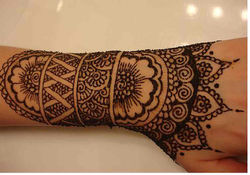 |
|---|
 |
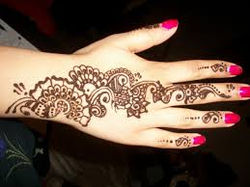 |
 |
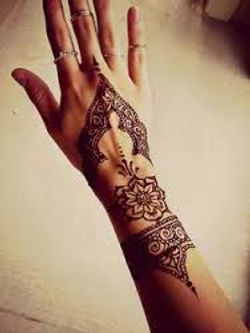 |
 |
 |
 |
 |
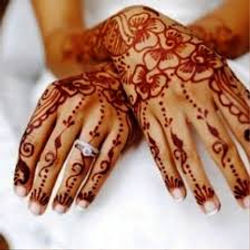 |
 |
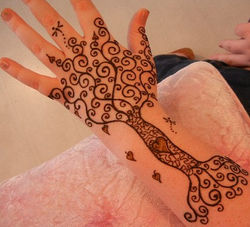 |
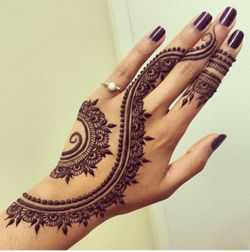 |
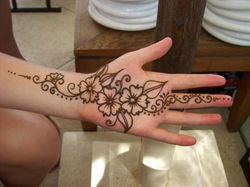 |
Or get it custom-made!!!
Either way, GT will make the process extremely comfortable and pleasing for you.
Prices
(1) Hand palm ----------------- $15.00
(1) Hand --------------------- $35.00
(1) Feet ---------------------- $45.00
(1) feet/knee ------------------ $60.00
Collarbone ------------------- $35.00
Lateral ----------------------- $80.00
Bi-lateral -------------------- $160.00
Back (spine) ------------------ $50.00
Back (whole) ----------------- $125.00
Belly chain -------------------- $35.00
Common Questions
Is henna safe?
Henna is safe for use on the skin and hair. Although it has been taken internally as a folk remedy for various stomach ailments, we do not recommend eating it! It tastes disgusting, and for those with the condition known as G6PD, it would be toxic (as would Fava Beans). Henna is also effective in treating athlete's foot and dandruff, due to its anti-fungal properties. Some people report henna to be soothing for skin conditions such as eczema and psoriasis, though it should never be applied to broken skin. Henna has also been used to reduce some of the painful side effects of Xeloda (a cancer drug).
Is henna safe for pregnant women?
Natural Henna is widely recognized by the medical community to be safe for pregnant women and is even recommended as an alternative to chemical hair dyes during pregnancy. However, you should always be sure that henna is 100% natural and has no chemical additives whether you intend to use it on hair or body. Henna is a beautiful way to celebrate pregnancy. Because of henna's cooling effects, it is traditionally used on the feet during pregnancy to reduce swelling especially in warm climates. The hennaing of the belly is a modern tradition, but we think it's just as beautiful and meaningful as doing the hands or feet. Henna has a way of being integrated into each culture that it visits and is used for ceremonial purposes across the globe.
How long does henna last?
Henna works by staining your dead skin cells. You have 7-10 layers of them on you. Right now. Even if you exfoliated this morning! Henna can last 1-4 weeks, but usually it looks fresh for about a week and fades after that, depending on how fast your skin is renewing itself. Swimming, washing dishes, and doing housework or strenuous activity like rock-climbing or yoga can accelerate the fading process. Henna is permanent on the hair and nails until they grow out.
Does it show up on darker skin tones?
Henna stains all skin types, but the hands and feet stain best (where the skin is most calloused) and the stain is fainter on other body parts, or almost invisible on the face or neck. On darker skin tones it is always recommended to henna the hands/feet for optimal visibility as other body parts such as the back or chest may not have enough contrast. Hands and feet are traditional for a reason!
Natural henna is an option!
What about henna for chemotherapy patients?
Henna is a wonderful way to "dare to go bare" during your chemotherapy or radiation treatments.
Maybe you don't want to wear an itchy wig, or swelter under a wooly hat in the middle of summer. Or maybe you'd just like to express yourself with beautiful artwork for everyone to see.
Henna is natural, safe, and promotes positive conversations and interactions during a challenging time. Be sure to check out my friend Frances Darwin's site Henna Heals for more information on this process.

What is Black henna?
Bad reaction from chemical henna paste. Technically, "black henna" is a misnomer. Sometimes, the herb Indigo will be labeled as black henna, because of it's ability to maintain black hair (Indigo actually yields a blue dye, the same dye that colors your jeans). But most often Black Henna is made of Coal Tar Dyes known as Paraphenyladiamine, or PPD for short. Recently it's referred to as "Para" or "kali mehndi". By any name, PPD is not safe for skin, and is banned by the FDA for use on skin. It can cause blisters, liver damage, fetal damage, and is known to be carcinogenic. Say no to "black henna", which is often found in tourist destinations like Mexico, Venice Beach, and even in India, Thailand, and Africa. Adding to the confusion, it is possible to get a nearly black stain on the palms from natural henna, when cared for properly. However, with a natural stain, the color starts out orange and darkens over 24-48 hours. Natural henna also needs to be left on for several hours to overnight. With "black henna", a jet black stain is achieved in just 20 minutes.
What henna does Greek Tanning use?
GT’s henna is certified by laboratory and safe to use. We can assure you that our product is purely herbal and has the best dyeing power you can get. 100% Ayurvedic product, clinically tested, no PPD or Ammonia.
